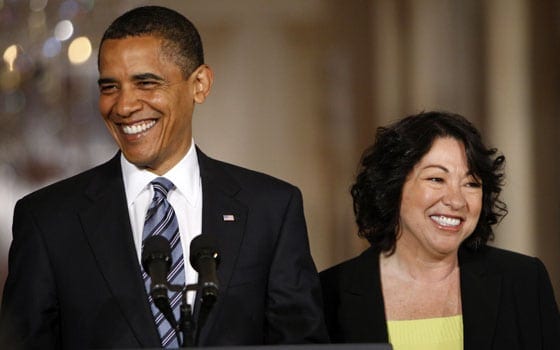
NEW YORK — Sonia Sotomayor’s path to the pinnacle of the legal profession began in the 1960s at a Bronx housing project just a couple of blocks from Yankee Stadium, where she and her family dealt with one struggle after another.
She suffered juvenile diabetes that forced her to start insulin injections at age 8. Her father died the next year, leaving her to be raised by her mother — a nurse at a methadone clinic who always kept a pot of rice and beans on the stove. The parents had moved to the U.S. from Puerto Rico.
Sotomayor immersed herself in Nancy Drew books and spent hours watching “Perry Mason” on television, and knew she wanted to be a judge by the age of 10 after being inspired by an episode of the show that ended with the camera settling on the robed sage.
“I realized that the judge was the most important player in that room,” Sotomayor said in a 1998 interview with The Associated Press.
Now, Sotomayor is one of the most important players in the nation after being nominated for a Supreme Court seat by President Barack Obama. It is the crowning accomplishment in a career that has included a long list of achievements: Yale Law School; a stint as a prosecutor and at a Manhattan law firm; a key ruling in 1995 that brought Major League Baseball back to the nation after a strike; and most recently a job as a federal appeals judge.
The Manhattan-born Sotomayor’s humble upbringing has shaped her personality — vibrant and colorful, and so different from the Bronx projects where she grew up in a working-class existence in a home with a drab yellow kitchen. She is a food-loving baseball buff as likely to eat a hot dog at a street corner stand as she is to sit down for a lengthy meal at a swanky Manhattan restaurant.
Her work and everything else in her life are sure to face close scrutiny in the months ahead in a process Sotomayor is all too familiar with. Her nomination to the appeals court was delayed 15 months, reportedly because of concerns by Republicans that she might someday be considered for the Supreme Court.
“I don’t think anybody looked at me as a woman or as a Hispanic and said, ‘We’re not going to appoint her because of those characteristics,’” she recalled in the 1998 interview. “Clearly that’s not what occurred.
“But I do believe there are gender and ethnic stereotypes that propel people to assumptions about what they expected me to be,” she continued. “I obviously felt that any balanced view of my work would not support some of the allegations being made.”
Her baseball ruling in 1995 was among the most important moments of her career. Because of her position on the bench in New York, she was put in the position to essentially decide the future of the sport she so loved.
Acknowledging the pivotal moment, Sotomayor described how it is “when you see an outfielder backpedaling and jumping up to the wall, and time stops for an instant as he jumps up and you finally figure out whether it’s a home run, a double or a single off the wall or an out.”
Then she scolded baseball owners for unfair labor practices and urged lawyers for striking players and the owners to salvage the 1995 season, reach a new labor agreement and change their attitudes.
As she showed with her March 1995 baseball ruling, the 54-year-old Sotomayor embraces the dramatic moment as well as any of the roughly 80 judges in the lower Manhattan courthouse that has been her home since her appointment to the bench in 1992 by President George H.W. Bush.
As a district judge, she advanced First Amendment religious claims by tossing out a state prison rule banning members of a religious sect from wearing colored beads to ward off evil spirits, and by rejecting a suburban law preventing the display of a 9-foot-high menorah in a park.
In 1995, she released the suicide note of former White House aide Vincent Foster, acting on litigation brought by the Wall Street Journal under the Freedom of Information Act.
Sotomayor, who has a brother who became a doctor, presided over a civil trial in 1996 in which the family of a lawyer who died from AIDS sued the makers of the movie, “Philadelphia,” contending that Hollywood stole their story. The case was settled, but not before the movie with its dramatic courtroom showdowns was aired in court in its entirety, prompting Sotomayor to caution: “I don’t expect melodrama here. I don’t want anybody aspiring to what they see on the screen.”
A year later, she ruled in favor of the creators of the “Seinfeld” show in a claim that a trivia book infringed on their television program’s copyright.
Sotomayor graduated summa cum laude from Princeton, then became an editor of the Yale Law Journal at Yale Law School. She then joined the Manhattan district attorney’s office and the board of the Puerto Rican Legal Defense and Education Fund.
She spent five years as a prosecutor before joining the midtown law firm of Pavia and Harcourt, where she worked eight years before her appointment to the federal bench.
Sotomayor is less affluent than many of the typical high court prospects. Though drawing a six-figure income, she lives in expensive Manhattan. Sotomayor earned $179,500 as a federal appellate judge in New York last year, plus $14,780 teaching at New York University’s law school and $10,000 as a lecturer at Columbia University’s law school, according to her most recent financial disclosure report.
Sotomayor owns a condominium in trendy Greenwich Village. She has had the property since at least 1998, and took out a $350,000 mortgage from JPMorgan Chase Bank last fall, the city records show. Sotomayor refinanced and used proceeds for renovations, her office said.
The condo, the only property Sotomayor owns, appears to be her primary asset. Other units in the building have sold for $900,000 to $1.5 million over the past five years, city records show.
Sotomayor listed two bank accounts as her only investments: $50,000 to $100,000 in a Citibank savings account and up to $15,000 in a checking account.
Since joining the 2nd U.S. Circuit Court of Appeals, Sotomayor has shown an independent streak and an interest in separating emotion from interpretation of the law, as she did in writing the dissent in a 2-to-1 decision in 2000. The appeals court ruled that the 1996 crash of TWA Flight 800 eight miles off the coast of Long Island occurred within U.S. territorial waters, allowing victims’ families to sue for damages that would have been barred if it happened in international seas.
Sotomayor said it seemed that the appeals panel was ignoring legislative history and earlier case law “in an understandable desire to provide the relatives and estate representatives … a more generous recovery.”
She said it was clear that Congress intended the Death on the High Seas Act to apply to any deaths that happened beyond three nautical miles from the U.S. coast and that those who drafted the law wanted to “provide a remedy, not the most generous remedy.”
Her rulings and comments during oral arguments also have reflected a law-and-order interest.
In 2000, she warned a lawyer who appealed the 30-year prison sentence given to a police officer who sodomized a defendant that the appeals court might suggest the sentence should be increased because of the brutality of the crime.
In 2007, she wrote an appeals opinion finding it was constitutional for state troopers to lure suspects away from two vehicles while they searched the cars for cocaine.
“There was ample probable cause to support these searches, and a disinterested magistrate judge assuredly would have issued a warrant had one been sought,” she wrote.
In another case, she gave an asylum seeker a second chance after his claim was rejected when he failed to appear at a hearing because his attorney was upstairs in possession of the document he needed to get into the building.
Sotomayor describes herself as “extraordinarily intense and very fun-loving.”
At a recent program honoring the creator of a documentary showing children who have thrived even in threatening environments, Sotomayor, her round face beaming, seemed to be enjoying the attention she was receiving as her nomination to the Supreme Court seemed likely.
In brief remarks, Sotomayor described the documentary as fabulous.
“We should applaud more frequently those who transform a lost life,” Sotomayor said.
As Sotomayor saw it, she was not so far from her humble childhood that she was not emotionally touched when she signed her first judgment of conviction after becoming a judge.
“That emotion will never leave me — humility,” she said. “A deep, deep sense of humility. And a deep, deep sense of there but for the grace of God could I have gone and many that I have loved.”
Associated Press writer Sharon Theimer in Washington contributed to this story.
(Associated Press)






